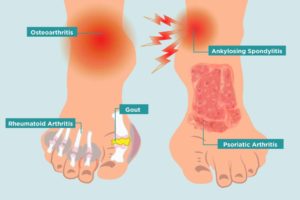
Types of arthritis, such as rheumatoid arthritis, osteoarthritis, and posttraumatic arthritis, affect the feet and cause difficulties in walking. Arthritis inflammation of the foot and ankle is because of the many joints present. There is no definite cure for arthritis, but the available treatments relieve symptoms and slow progression. Many patients have managed to lead fulfilling lives through arthritic foot pain relief, and they have remained active after proper treatment.
If you have questions about caring for arthritis of the foot or ankle, reach out to a foot specialist for his/her expert advice. Feel free to contact our office to make an appointment with our podiatrist. Our foot and ankle doctor, Dr. Ejodamen Shobowale, will provide you with the care you need to keep you pain-free on your feet.
Osteoarthritis – This is degenerative arthritis is common in middle-aged people. It is known as wear-and-tear, but younger people can suffer from it too. In this condition, the cartilage in the joints wears away, decreasing the protective space. It may produce painful bone spurs as the bones rub against one another. Other risk factors include inheritance and obesity. Osteoarthritis slowly causes stiffness and pain.
Rheumatoid arthritis – This chronic disease affects multiple joints but starts in the foot and ankle. Back pain and rheumatoid arthritis happen when the immune system attacks its tissues, starting with the synovium that covers the joints causing swelling to the joints. With time the synovium damages the cartilage, bones, tendons, and ligaments causing serious disability and deformity. It is not inherited but some genes make people susceptible to be affected by it. Even when you have the genes, getting infected is not automatic there must be a trigger that activates the condition. Once exposed to the trigger the immune system starts to attack the joints.
Posttraumatic arthritis – This condition often develops after an injury to the ankle or foot. Damage caused to the joint surface through fractures and dislocations leaves the ankle and foot vulnerable to posttraumatic arthritis. It may take few years after injury to develop this condition. An injured joint is more likely to be arthritic later even after proper treatment. An injury may cause the body to secrete hormones that eventually kill the cartilage cells affecting the joints.
Nonsurgical Treatment for Arthritis or Arthritic Feet
The first treatment for arthritic feet is usually nonsurgical, and the foot doctor can recommend a combination.
- Lifestyle modification
This means making changes to your daily life to slow the progression of the disease and relieve the pain of arthritis. These changes include:
- Switch to low-impact activities such as swimming to lessen pressure on the foot and ankle.
- Minimize activities that aggravate the condition.
- Losing weight is very effective to lessen the pain in the joints and increase functions.
- Physical therapy
Seek a professional who will guide you to work on specific exercises that will increase flexibility and range of motion. Have an individual exercise program to help strengthen your foot and ankle muscles but still meet your lifestyle and needs. Sometimes, physical therapy may intensify joint pain due to friction between the arthritic joints. In case the pain intensifies, stop the treatment and consult your foot doctor.
- Use assistive devices.
Devices such as braces can help improve mobility and shoe inserts decrease pain to the foot by minimizing pressure on the foot. In cases where the foot is deformed, the inserts tilt the ankle and foot to straighten and decrease pain.
- Medications
You can use over-the-counter painkillers to relieve pain and reduce swelling. The podiatrist might administer cortisone injections to the affected joint; they are very effective in relieving pain. However, the effects of the painkillers are temporary.